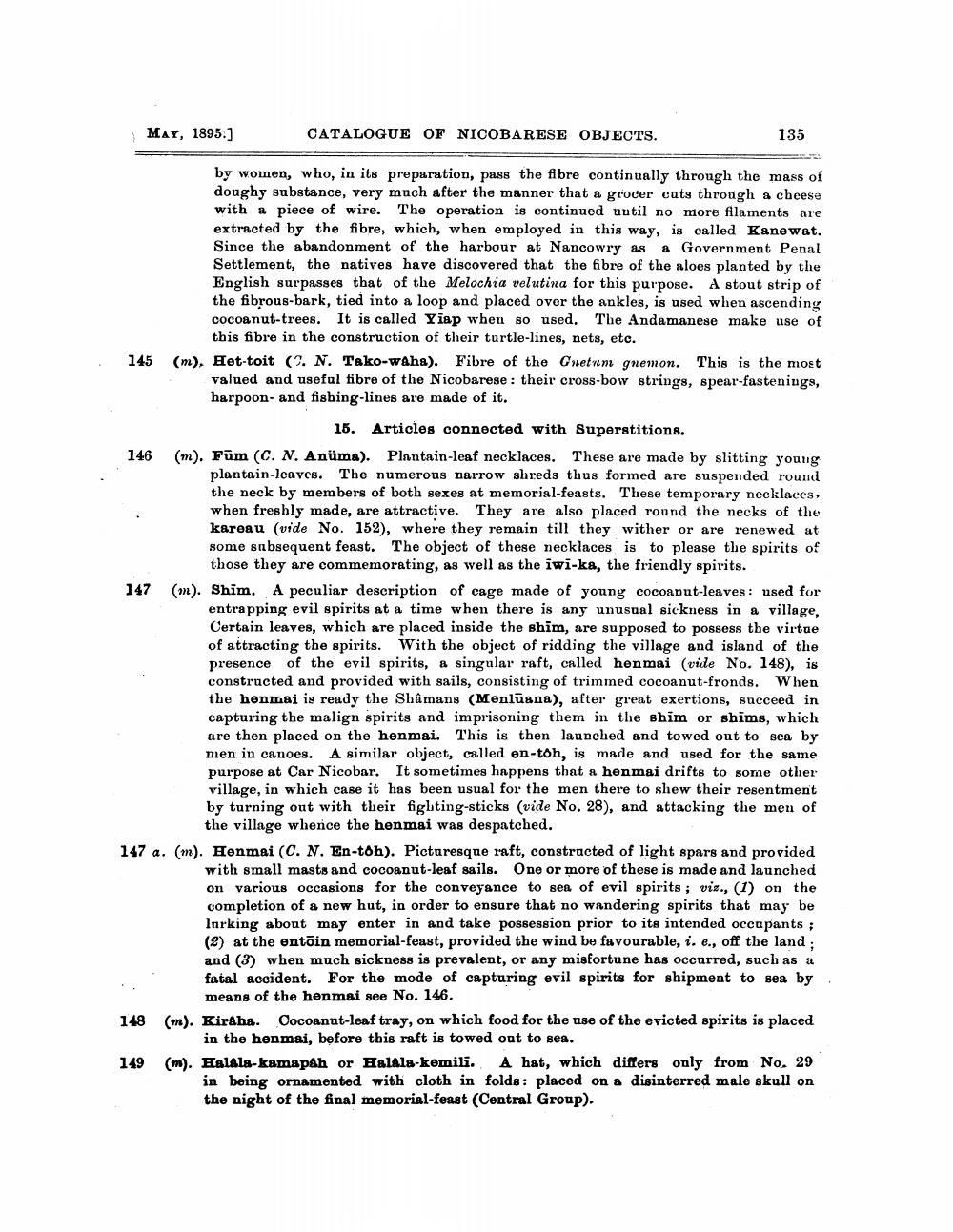________________
Mar, 1895.]
CATALOGUE OF NICOBARESE OBJECTS.
135
by women, who, in its preparation, pass the fibre continually through the mass of doughy substance, very much after the manner that a grocer cuts through a cheese with a piece of wire. The operation is continued until no more fllaments are extracted by the fibre, which, when employed in this way, is called Kanewat. Since the abandonment of the harbour at Nancowry as a Government Penal Settlement, the natives have discovered that the fibre of the aloes planted by the English surpasses that of the Melochia velutina for this purpose. A stout strip of the fibrous-bark, tied into a loop and placed over the ankles, is used when ascending cocoanut-trees. It is called Yiap when so used. The Andamanese make use of
this fibre in the construction of their turtle-lines, nets, etc. (m), et-toit . N. Tako-waha). Fibre of the Cretvom gnemon. This is the most
valued and useful fibre of the Nicobarese: their cross-bow strings, spear-fastenings, harpoon- and fishing-lines are made of it.
145
15. Articles connected with Superstitions. 146 (m). Füm (C. N. Anüma). Plantain-leaf necklaces. These are made by slitting young
plantain-leaves. The numerous narrow shreds thus formed are suspended round the neck by members of both sexes at memorial-feasts. These temporary necklaces, when freshly made, are attractive. They are also placed round the necks of the kareau (vide No. 152), where they remain till they wither or are renewed at some subsequent feast. The object of these necklaces is to please the spirits of
those they are commemorating, as well as the iwi-ka, the friendly spirits. 147 (m). Shim. A peculiar description of cage made of young cocoaput-leaves: used for
entrapping evil spirits at a time when there is any unusual sickness in a village, Certain leaves, which are placed inside the shim, are supposed to possess the virtue of attracting the spirits. With the object of ridding the village and island of the presence of the evil spirits, a singular raft, called hennai (vide No. 148), is constructed and provided with sails, consisting of trimmed cocoanut-fronds. When the hennai is ready the Shamans (Menlūana), after great exertions, succeed in capturing the malign spirits and imprisoning them in the shim or shims, which are then placed on the henmai. This is then launched and towed out to sea by men in canoes. A similar object, called en-toh, is made and used for the same purpose at Car Nicobar. It sometimes happens that a henmai drifts to some other village, in which case it has been usual for the men there to shew their resentment by turning out with their fighting-sticks (vide No. 28), and attacking the men of
the village whence the henmai was despatched. 147 a. (m). Henmai (C. N. En-toh). Picturesque raft, constructed of light spars and provided
with small masts and cocoanut-leaf sails. One or more of these is made and launched on various occasions for the conveyance to sea of evil spirits ; viz., (1) on the completion of a new hut, in order to ensure that no wandering spirits that may be larking about may enter in and take possession prior to its intended occupants ; (2) at the entoin memorial-feast, provided the wind be favourable, i. e., off the land : and (3) when much sickness is prevalent, or any misfortune has occurred, such as a fatal accident. For the mode of capturing evil spirits for shipment to sea by:
means of the henmai see No. 146. 148 (m). Kiraba. Cocoanat-leaf tray, on which food for the use of the evicted spirits is placed
in the henmai, before this raft is towed out to sea. 149 (m). Halala-kamapah or balala-kemili. A hat, which differs only from No. 29
in being ornamented with cloth in folds: placed on a disinterred male skull on the night of the final memorial-feast (Central Group).




